23 Vaccine Technology
Kendall Ringo
23.1 Introduction
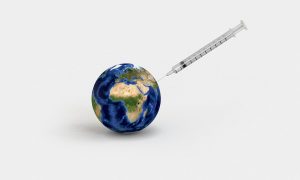
“Syringe World Medicine” by Arek Socha, Pixabay is under a Pixabay License.
Keywords
- Variolation– a method of immunizing patients against smallpox by infecting them with substance from the pustules of patients with a mild form of the disease
- Eradicate– the permanent reduction to zero of the worldwide incidence of infection caused by a specific agent as a result of deliberate efforts; intervention measures are no longer needed
- Incidence– the number of new cases of disease in a given population
- Immune system– a complex network of cells, tissues, organs, and the substances they make that helps the body fight infections and other diseases
- Antibody– a protein molecule that can be found in the blood and is intended to attack antigens
- Herd immunity– a form of indirect protection from infectious disease that can occur with some diseases when a sufficient percentage of a population has become immune to an infection, reducing the likelihood of infection for individuals who lack immunity
- Placebo group– the group that receives an inactive substance that looks like the drug or treatment being tested to act as a control
- Efficacy– the degree to which a vaccine prevents disease, and possibly also transmission, under ideal and controlled circumstances
- Pathogen– a bacterium, virus, or other microorganism that can cause disease
- Pandemic– an outbreak of an infectious disease that has spread across a large region, for instance multiple continents or worldwide
Learning Objectives
By the end of this chapter, students should be able to:
- Describe what a vaccine is and how it works to prevent the spread of infectious disease.
- Differentiate between vaccination and variolation.
- Describe how vaccination technology has impacted society.
- List the limitations of vaccination technology.
- Make predictions about how vaccination technology may advance in the future.
It’s estimated that as a result of vaccination, 103 million cases of infectious childhood diseases have been prevented between 1924 and 2010 in the United States (Iwasaki & Omer, 2020). In other words, millions of lives have been saved because a large range of diseases caused by both viruses and bacteria can be stopped by the use of vaccines. Despite this, there is still controversy surrounding the topic of vaccination, likely due to a lack of education on the science behind it. Although it’s become somewhat controversial, vaccination has been proven to be effective, and developments in vaccine technology have positively impacted the world by allowing us to control and eradicate infectious diseases.
Given that as this text was written, the world was in the midst of the COVID-19 pandemic, it’s so important, now more than ever, to be educated on vaccination and why it’s effective. In the past, the incidence of a disease has always declined after a vaccine for that disease has been approved for use, suggesting that vaccines definitely play a vital role in slowing the spread of disease. In this chapter we will discuss how vaccines originated, how they’re developed, how they’re administered, and how they work in the body. By looking at the history, current impact, and future of vaccines, it’s clear that vaccination is the most effective way to prevent disease and mortality. Vaccines are arguably one of the most influential medical technologies ever created.
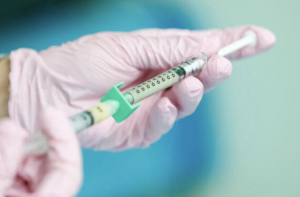
“Huge study on another COVID vaccine is underway” by Abel F. Ros, Qapta.es is licensed under CC BY-NC-SA 4.0
23.2 How Vaccination Works
Key Takeaway
Vaccination is used in order to prompt an immune response to a disease so that antibodies can be made before an individual comes into contact with the disease naturally. There are different ways that vaccines can be made and administered.
Vaccines are versatile in that they can be made and administered in many different ways, such as nasal spray and intradermal injection. Even though the forms of vaccination and the ingredients used to make vaccines may be different, they all aim to have the same effect. The goal of vaccination is to expose the body to a pathogen, whether it’s a virus or bacteria, and allow the immune system to build antibodies so that if the individual comes into contact with the disease again, the body can fight it off and the illness will be less severe. Vaccines also go through many rounds of testing and trials before they are licensed and made available to the general public to ensure their effectiveness and to make note of any side effects.
23.2.1 What goes into a vaccine?
Vaccines contain pieces of the disease causing agent or the instructions for making the pieces. There are also other ingredients added to vaccines to ensure that they are safe and successful in creating antibodies. There are many ingredients that go into a vaccine, and each one serves a different purpose:
- Antigen: The active component that generates an immune response. It’s possible for the antigen to be a part of the disease causing agent, such as a protein, or the whole disease causing agent in a weakened form.
- Preservative: Prevents vaccine vials that contain multiple doses from becoming contaminated after the vial has been opened. The most commonly used preservative is 2-phenoxyethanol.
- Stabilizer: Prevents chemical reactions from happening inside the vial, and ensures that other components will not stick to the vial. Common stabilizers include sugars, amino acids, gelatin, and proteins.
- Surfactant: Keeps all of the ingredients blended together by preventing the clumping of the components in the liquid form of a vaccine.
- Residual: Extremely small amounts of other substances that are used in production that aren’t active ingredients in the finished vaccine. This may include egg proteins, antibiotics, or yeast.
- Diluent: A liquid, most often sterile water, that is used to perfect the concentration of a vaccine right before it is used.
- Adjuvant: Keeps the vaccine at the injection point for longer periods of time or stimulates local immune cells in order to improve the immune response to the vaccine. An adjuvant will most likely be a small amount of aluminum salts.
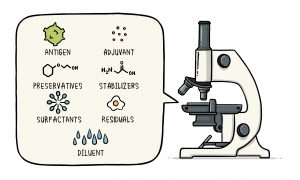
“WHO EN Vaccines Topic Two Ingredients static” by World Health Organization is licensed under CC BY-SA 3.0
23.2.2 How do vaccines work with the immune system?

Graphic by Kendall Ringo.
23.2.3 The Process of Vaccine Approval
When a vaccine has been developed, it is required to be thoroughly tested in order to ensure its safety. The first step is to perform screenings and evaluations in order to determine which antigen creates the best immune response. These experimental vaccines cannot be tested on humans, so they are initially observed in animals. If the vaccine is successful in creating a response from the immune system, it moves on to clinical trials in humans, which involves three main phases.
- Phase 1: The vaccine is given to a small group of healthy young adults to confirm that it’s safe, generates an immune response, and to determine the correct dosage.
- Phase 2: The vaccine is given to a few hundred people, and compared to a similar group of people who did not receive the vaccine, otherwise known as the placebo group. The many trials conducted within this phase help to determine the difference in effects based on traits like age, and different formulations of the vaccine. The two groups are compared to ensure that the immune response resulted from the vaccine and not by chance.
- Phase 3: This phase is the same as phase 2, except the vaccine is given to thousands of people instead of hundreds. Testing on such a large group of people further confirms the safety and effectiveness of the vaccine. The third phase is usually conducted across different countries, and different areas of each country.
When the data from these clinical trials are released, there are a few more steps before a vaccine is approved for general use. Public health officials closely analyze the results of the study and determine whether the vaccine should be approved. The standards for approval are very high. After a vaccine is in use, it must be monitored for safety and efficacy continuously. This data allows scientists to keep track of the impact of vaccines and to advocate for policies that will create herd immunity, therefore optimizing the effects of the vaccine.
23.3 The Origin of Vaccination
Key Takeaway
Before modern vaccine technology, variolation was the technique used to protect against infectious diseases. Different scientists have contributed to vaccine technology and allowed it to advance over time.
Before vaccines, infectious diseases claimed countless lives. In medieval times, herbal remedies were often used to fight these diseases, but variolation was the first science-based effort to control and begin to fight the spread of these infectious diseases. The beginning of the modern vaccination technique did not begin until the late 1700s, but it has been evolving ever since. Thanks to the work of various scientists over the last few centuries, we have now learned how to make safe and effective vaccines that have the potential to completely eradicate deadly diseases.
23.3.1 Variolation
The technique of variolation, also referred to as inoculation, was originally practiced in Africa, China, India, and Turkey to treat smallpox for centuries before being introduced into the West during the Ottoman Empire. This technique involved taking the pus from an individual infected with smallpox, and then inserting it under the skin of the arms or legs of someone who had not been infected. Even though this method proved to be effective, there were sometimes concerns that the recipient may actually develop smallpox, or be at risk for bloodborne diseases such as syphilis. Variolation was introduced into Europe by traders from Istanbul in the early 1700s, but it was not until British aristocrat, Lady Mary Wortley Montague advocated for its use that it became generally accepted in England. The variolation technique was widely popular until the discoveries of scientist Edward Jenner.
23.3.2 The History of Modern Vaccination
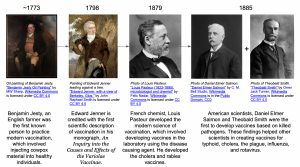
Graphic by Kendall Ringo.
23.4 The Impact of Vaccines on Society
Key Takeaway
Vaccination has allowed us to take control over infectious diseases and even begin to eradicate them. Despite this victory, vaccines have limitations, and have become controversial among certain groups over time.
Vaccines have certainly had a large impact on medicine and society, as it’s now possible to completely eliminate a disease that may have once killed thousands. Getting vaccinated can save an individual’s life. This shifts concern away from infectious disease and allows medicine to address chronic disease, which is much more prevalent now. Although the pros of vaccination will always outweigh the cons, there are some limitations that should be addressed. Due to the rise of social media, and the strong value of individual liberty in the West, vaccination has become controversial.
23.4.1 The Benefits of Vaccination
Vaccines save lives. According to the American Academy of Pediatrics, childhood vaccination is 90-99% effective in preventing disease. In most cases, there is nothing to be worried about when deciding whether to become vaccinated. The ingredients used in vaccines have been tested to ensure that they are not harmful in small doses, and major medical organizations like the Center for Disease Control, the Institute of Medicine, and the American Medical Association state that vaccines are completely safe. Not only does getting vaccinated benefit the individual, but it protects those who cannot receive vaccines due to allergies or autoimmune disorders by limiting the spread. Adverse reactions to a vaccine are extremely rare for a healthy individual. In addition, many preventable diseases have not yet been eradicated, so in order to hopefully achieve that, it’s very much still important and necessary.
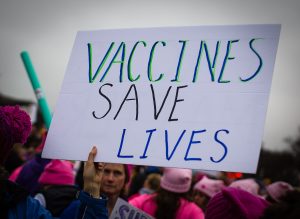
“Vaccines Save Lives” by Johnny Silvercloud, Wikimedia Commons is licensed under CC BY-SA 2.0
23.4.2 The Limitations of Vaccination
Although vaccines are one of the most important medical technologies, they do have limitations, just like anything else. The biggest and most obvious, is that vaccines may not always be effective due to the fast-mutating nature of some infectious diseases. This means that the disease is constantly changing, so a vaccine for one strain of disease may not work to fight against another strain of the same disease. In addition, vaccines sometimes use animal products, which goes against the beliefs of vegans and vegetarians, or other ingredients that people don’t believe are safe. Another common belief is that big pharmaceutical companies should not be trusted to develop vaccines, as their main goal is to make a profit. Lastly, vaccines do have the very rare potential to cause fatal allergic reactions.
23.4.3 The Controversy Surrounding Vaccination
With the rise of social media, it’s become a lot easier for people to voice their opinions on important issues. Vaccines have been controversial for decades now, after a false study linking childhood vaccination to autism became popular, however it wasn’t until very recently that the conversation of vaccines became controversial yet again. When the vaccine for COVID-19 was introduced during the ongoing pandemic, many people were conflicted on whether to get it, and whether it was safe. This hesitation was fueled by a very harsh political climate, and a very heated presidential election.
There was then a mass spread of misinformation about vaccines on social media sites like Instagram and FaceBook. Some claimed they didn’t believe that scientists had taken enough time to develop a vaccine that they knew was safe, and others claimed that the COVID-19 vaccine was a way for the government to microchip them, or even to cause adverse health effects intentionally. It may be clear that these outrageous claims are not true, but to some it’s not so obvious. This recent controversy proves why people should be educated on vaccination, in order to prevent harmful ideas like these from spreading.
As different states and businesses began to require proof of vaccination to participate in things, people became even more upset as they believed that their personal liberties were being taken away. In order to get around these requirements, opposers have argued that getting vaccinated goes against their religion or culture. Some have faked vaccine documents, and have even gone on strike or quit their jobs because they refuse to get vaccinated. Health organizations are working hard to eliminate misinformation and further prove that vaccination is safe and effective.
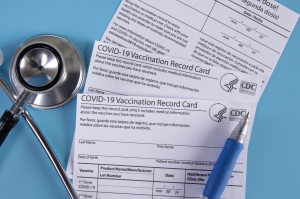
“Three covid-19 vaccination record cards” by Jurnej Furman, Flickr is licensed under CC BY 2.0
Case Study: The DRC Ebola Epidemic
Ebola is a deadly virus that spreads through bodily fluids and causes damage to the immune system, organs, and uncontrollable bleeding. The virus specifically affects communities in Africa due to cultural funeral practices where loved ones come into contact with the deceased. In 2018, there was a massive outbreak in the Democratic Republic of the Congo. Ebola infected over three thousand people and killed 66% of them (Maxmen, 2020). This outbreak was complicated, because the DRC is a dangerous area impacted by war and political instability. This put sick people who sought care in harm’s way, and ultimately caused more people to die. Drug company, Merck of Kenilworth, had tested a vaccine during a previous outbreak, and it was now ready for use. This vaccine was given to three hundred thousand people who had been in contact with someone who had ebola. Over 80% of those vaccinated did not get ebola, and those who did old had mild cases (Maxmen, 2020). This allowed public health officials to get the outbreak under control, and in May of 2021, the DRC ministry of health and the WHO declared the ebola epidemic to be over.
23.5 The Future of Vaccination
Key Takeaway
In the future, there will be advancements in the different types of vaccines that can be used, and an increase in both accessibility and acceptance of vaccination.
There are various diseases such as influenza, HIV, and herpes that are antibody resistant, and therefore making the current methods of vaccination less effective in fighting them. The new development of T-cell vaccines is a promising solution. T cells work by recognizing pathogens in the body, but to develop memory T cells, T cells must be present at the point of entry. Developing a prime-and-pull strategy when administering a vaccine would be effective in doing that. This would involve first administering a conventional vaccine, and then application of a topical cream or solution that would attract T cells to the site of the virus growth. This method of vaccination could allow for the development of vaccines targeting antibody resistant pathogens and cancer as well, as in these cases no surface antigens can be detected.
A second exciting possibility is the development of mucosal vaccines. Due to the fact that most pathogens enter the body through mucosal surfaces like the nose, eyes, and mouth, mucosal immunity could be effective in blocking infection all together. If these vaccines are developed in the future, they’d be revolutionary, as currently vaccines are injected into the muscle, without any plans to increase mucosal immunity.
Vaccines are currently given subcutaneously, or into the muscle, but there have been developments in creating new intradermal vaccines. This new delivery system could eliminate the need for a trained health professional to administer the vaccine, therefore increasing access to people in areas or countries that don’t have strong healthcare systems. This method would also increase dosage consistency, in turn increasing vaccine efficacy. Non-invasive transdermal vaccination methods are also in development, however they’re not the most economically friendly way, nor is the technology that would be needed for this to be successful fully understood yet.
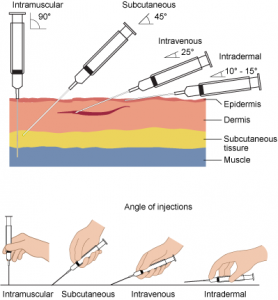
“Needle Insertion Angles “ by British Columbia Institute of Technology, Wikimedia Commons is licensed under CC BY 4.0
Chapter Summary
Originally, variolation was the way in which people protected themselves against infectious diseases, but thanks to the work of Edward Jenner, modern vaccine technology took its place. Vaccination is the most effective way to prevent disease and mortality, and vaccines are arguably one of the most influential medical technologies ever created. They’re carefully designed to familiarize the immune system with a pathogen before an individual naturally comes into contact with it, therefore preventing them from becoming fatally ill. Diseases like smallpox, the flu, and recently coronavirus, that have previously killed many are no longer a certain death sentence. Before a vaccine is approved for general use, it goes through very thorough testing to ensure that it’s safe and effective. The future of vaccine technology is promising, as it offers methods to expand accessibility and create greater immunity. However, misinformation and the mistrust of vaccinations are a threat to their success and positive impact on global human health.
Review Questions
1. Which of the choices below correctly describes variolation?
A. A person infected with smallpox coughs into the mouth of a non-infected, non-immune individual.
B. A weakened version of smallpox is injected into the muscle of a non-infected, non-immune individual.
C. The material from pustules on a person infected with smallpox is inserted into the body of a non-infected, non-immune individual.
D. A non-infected, non-immune individual remains in close contact with individuals infected with smallpox, but their natural immunity is able to fight it off.
2. What is the main job of a vaccine?
A. A treatment for a disease after the individual has already become infected.
B. To damage the immune system.
C. Make an individual become fully infected with a disease, because it’s impossible to become infected a second time.
D. Allow the body to build antibodies against a disease before the individual naturally comes into contact with it.
3. What is the biggest limitation of modern vaccine technology?
A. Some pathogens mutate too quickly for a vaccine to be effective in stopping the spread.
B. Vaccines cause autism in children.
C. The current technology is not economically favorable.
D. Vaccines are not effective for preventing a disease caused by bacteria.
4. Which of the following is not a common ingredient in a vaccine?
A. Antigen
B. Antibody
C. Surfactant
D. Diluent
Answers:
- C
- D
- A
- B
Food for Thought
- What are possible solutions to the spread of misinformation and distrust of vaccines?
- How might increasing the effectiveness and accessibility of vaccines benefit society? Are there any negative consequences?
References
Amin, A.B., Bednarczyk, R.A., Ray, C.E., Melchiori, K.J., Graham, J., Huntsinger, J.A., & Omer, S.B. (2017). Association of moral values with vaccine hesitancy. Nature Human Behavior, 1, p. 873-880.
Hinman, A. (1999). Eradication of Vaccine-Preventable Diseases. Annual Review of Public Health, 20(1), p. 211-229.
Iwasaki, A., & Omer, S. (2020). Why and How Vaccines Work. Cell, 183(2), p. 290-295.
Jenner, E. (1798). An inquiry into the causes and effects of the variolae vaccine. Murray and Highley.
Kim, H., Han, J.Y., Yoon, H.J, Ko, Y., & Seo, Y. (2020). Effects of Facebook Comments on Attitude Toward Vaccines: The Roles of Perceived Distributions of Public Opinion and Perceived Vaccine Efficacy. Journal of Health Communication: International Perspectives, 25(2), p. 159-169.
Lambert, P.H., & Laurent, P.E. (2008). Intradermal vaccine delivery: Will new delivery systems transform vaccine administration. Vaccine, 26(26), p. 3197-3208.
Maxmen, A. (2020, June 26). World’s second-deadliest Ebola outbreak ends in Democratic Republic of the Congo. Nature. https://www.nature.com/articles/d41586-020-01950-0.
Plotkin, S.A., & Plotkin, S.L. (2011). The development of vaccines: How the past led to the future. Nature Reviews Microbiology, 9, p. 889-893.
Riedel, S. (2005). Edward Jenner and the history of smallpox and vaccination. Baylor University Medical Center Proceedings, 18(1), p. 21-25.
Siegrist, C.A, & Lambert, P.H. (2016). The Vaccine Book. Academic Press. https://doi.org/10.1016/B978-0-12-802174-3.00002-3.
Van Panhuis, W.G., Grefenstette, J., Jung, S.Y., Chok, N.S., Cross, A., Eng, H., Lee, B.Y., Zadorozhny, V., Brown, S., Cummings, D., & Burke, D.S. (2013). Contagious Diseases in the United States from 1888 to Present. The New England Journal of Medicine. 369(22), 2152-2158.
World Health Organization. (2020, December 8). How are vaccines developed? World Health Organization. https://www.who.int/news-room/feature-stories/detail/how-are-vaccines-developed.
The permanent reduction to zero of the worldwide incidence of infection caused by a specific agent as a result of deliberate efforts; intervention measures are no longer needed.
A disease that spreads across several countries or continents, usually affecting a large number of people.
The number of new cases of disease in a given population.
A bacterium, virus, or other microorganism that can cause disease.
A complex network of cells, tissues, organs, and the substances they make that helps the body fight infections and other diseases.
A protein molecule that can be found in the blood and is intended to attack antigens.
The group that receives an inactive substance that looks like the drug or treatment being tested to act as a control.
The degree to which a vaccine prevents disease, and possibly also transmission, under ideal and controlled circumstances.
A form of indirect protection from infectious disease that can occur with some diseases when a sufficient percentage of a population has become immune to an infection, reducing the likelihood of infection for individuals who lack immunity.
A method of immunizing patients against smallpox by infecting them with substance from the pustules of patients with a mild form of the disease.

